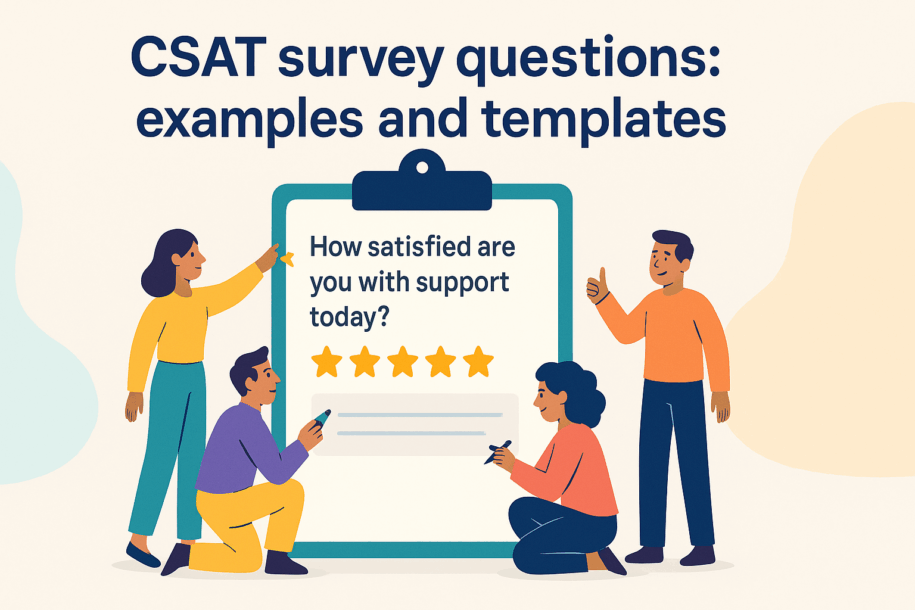The right CSAT survey questions help you learn faster, keep customers, and improve your help desk without extra tools. In this guide you will get copy and paste templates, smart timing rules, and a rollout plan that fits small teams.
Why CSAT survey questions matter
CSAT is simple to ship and easy to read. Because the scale is familiar, customers answer quickly and you get a reliable signal of how support feels right now. Better yet, you can launch CSAT inside your current help desk and start learning this week.
- Faster feedback leads to better prioritization and fewer repeats.
- Clear language reduces bias and increases response rate.
- Tight loops make it easier to coach agents and fix process gaps.
For useful context on speed and customer expectations, see these helpdesk response time benchmarks and our overview of helpdesk metrics small teams should track.
CSAT survey questions you can use today
Keep the wording short. Use a 5 point or 7 point scale, then add a single open follow up. The exact phrasing matters, so copy these as is and adapt only the bracketed parts.
After resolution template
Question:
How satisfied are you with the support you received today?
Scale:
Very dissatisfied, Dissatisfied, Neither, Satisfied, Very satisfied
Optional NPS-style variant:
How likely are you to recommend our support to a friend or colleague?
0 to 10 scale
Open follow up:
What is one thing we could improve about this experience?
Why it works:
It uses plain words. It references support rather than the product. Therefore the score reflects your team, not a feature request.
Onboarding checkpoint template
Question:
How satisfied are you with the help you received getting started?
Scale:
Very dissatisfied, Dissatisfied, Neither, Satisfied, Very satisfied
Open follow up:
What step felt confusing or slower than expected?
Why it works:
It targets the onboarding moment, which often hides friction. Answers guide docs and saved replies, not just tickets.
Feature request follow up template
Question:
How satisfied are you with how we handled your request?
Scale:
Very dissatisfied, Dissatisfied, Neither, Satisfied, Very satisfied
Open follow up:
What outcome would have made this a great experience?
Why it works:
It separates satisfaction with the process from the product roadmap. As a result, you learn where communication needs a tune up.
Tip: Keep your CSAT survey questions in a shared document so agents can reuse exact copy in saved replies.
When and where to ask
Ask at natural milestones, not in the middle of a conversation. You will get clearer answers and better response rates.
Email vs in-app delivery
- Email is easiest to ship today. You can send a one click survey or a short form and track replies in the help desk.
- In-app prompts are great for onboarding or education steps. However, keep them short and respect rate limits.
Timing rules that prevent fatigue
- Trigger CSAT after you set a ticket to Resolved, not after first response.
- Do not survey the same customer more than once in 7 to 14 days.
- For long threads, wait until the customer confirms the fix.
- Avoid sending surveys at night outside the customer’s timezone.
For background on human timing limits and perceived speed, Nielsen Norman Group’s research on three important response time limits is a helpful reference.
Measure, learn, and act
Raw scores are not enough. You need a tiny dashboard and a habit of closing the loop.
Targets and tiles to watch
- CSAT score 80 percent or higher is a solid first target for small teams.
- Response rate 15 to 30 percent is realistic for email surveys.
- Top themes from open comments, grouped weekly.
- Follow up rate on dissatisfied responses, owned by a lead.
A concise business case for improving experience is outlined in this specific Harvard Business Review study.
Close the loop with saved replies
- Thank every customer who left feedback.
- For low scores, ask one clarifying question and offer a simple fix.
- If you shipped a change based on feedback, tell the customer. This turns detractors into promoters.
Rollout plan for your team
Start small, then expand with confidence. A clear plan keeps your CSAT survey questions accurate and reduces noise.
One page playbook
- Where you will ask, when you will ask, and the exact text.
- Who owns follow ups on dissatisfied replies and within what time.
- How you will calculate and share the score every week.
Common pitfalls and quick fixes
- Leading words in questions lower trust. Keep phrasing neutral.
- Too many surveys reduce response rates. Add a frequency cap.
- No owner for follow ups drains value. Assign a name to each queue.
If you are setting SLAs in parallel, pair this rollout with our helpdesk SLA template examples. If you need to improve speed before surveying, review helpdesk response time benchmarks.
FAQ about CSAT survey questions
What scale should we use?
Use 5 points for clarity. Use 7 points only if your audience is analytical and you need more variance.
Should we translate the survey?
Yes if your customer base spans regions. Keep the tone consistent across languages.
Can CSAT live inside our help desk?
Yes. Many teams start with saved replies and a simple form link. You can add automation later.
Conclusion
A few well written CSAT survey questions deliver fast insight without heavy tools. Start with three templates, ask at the right moments, and act on what you learn. Over time, your score will rise along with renewals and referrals.
Start your free 14 day trial to launch CSAT with copy and paste templates, smart timing rules, and a simple dashboard built for small teams.
